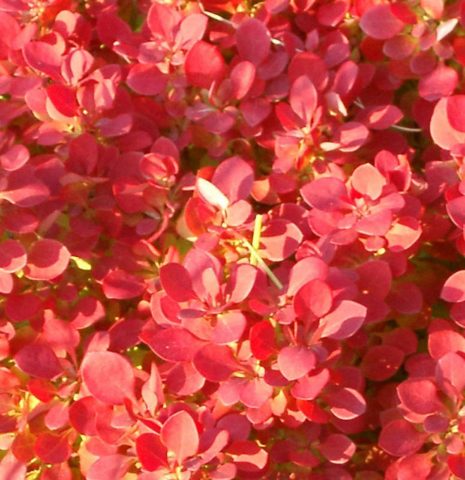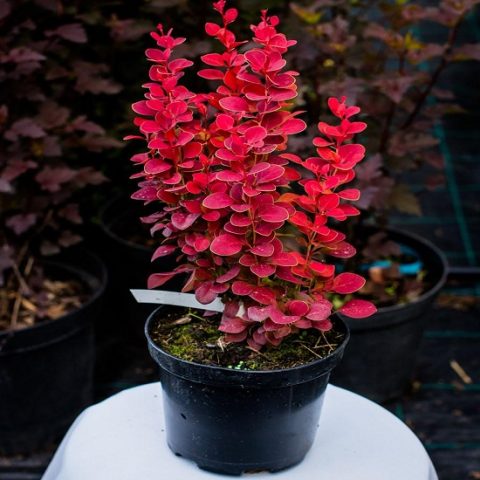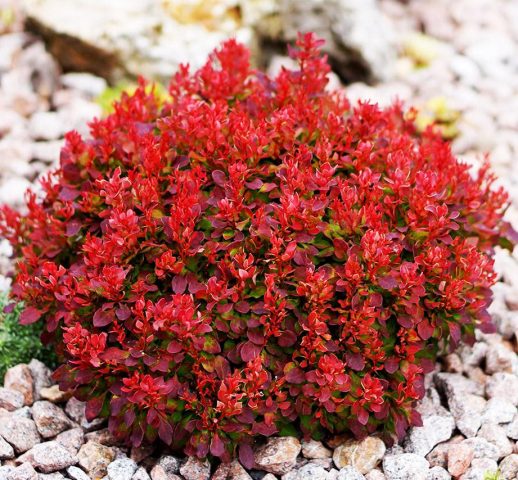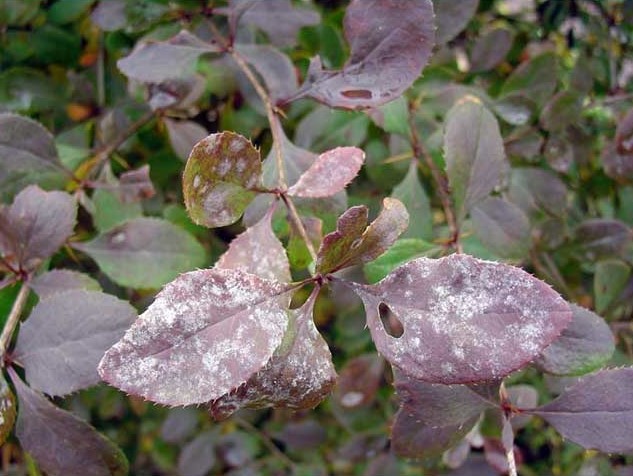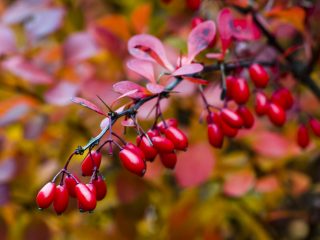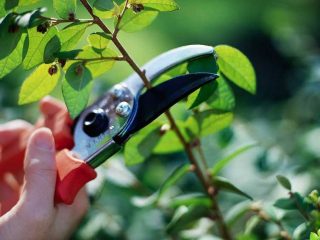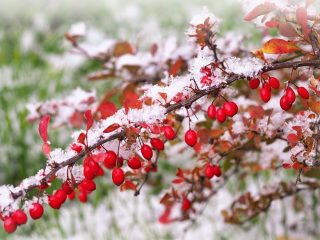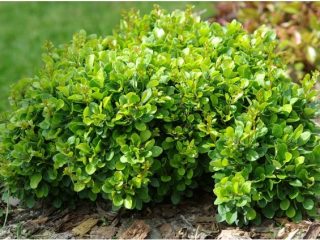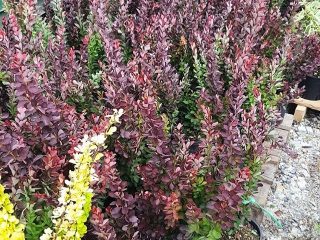Content
Barberry Lutin Rouge is a winter-hardy deciduous shrub of the Barberry family, unpretentious in care and resistant to most diseases of garden crops. The variety is distinguished by its immunity to air pollution, due to which it is often used for landscaping city parks.
Description of barberry Lutin Rouge
Barberry Thunberg variety Lutin Rouge is a compact shrub with abundant shoot formation. The crown of the plant is dense and dense.
The dimensions of an adult shrub reach 50 cm in height and 70-80 cm in width. The foliage of barberry Lutin Rouge in the spring has a light green color, however, in the fall the color of the leaf blades turns into rich orange tones with a red tint.
The shoots of the plant are covered with light long spines, thin and elastic to the touch. The fruits of the Thunberg barberry variety Lutin Rouge are inedible, according to the description of this garden crop. Their shape resembles an oval, and the skin has a bright red color. The size of the fruit does not exceed 1 cm in diameter. Even after ripening, they do not fall from the branches for a long time, giving the bush a decorative appearance.
Planting and care
Despite the fact that the Thunberg barberry Lutin Rouge is a rather unpretentious variety, it is recommended to take a responsible approach to choosing a place for planting the plant - only in this case the decorative value of the shrub will be fully revealed.
There are a number of general recommendations for planting:
- Barberry variety Lutin Rouge prefers open sunny areas. It also grows well in moderate shade conditions.
- The shrub is often planted in shaded places without any particular harm to its development, but in this case the decorative appearance of barberry foliage will suffer - the leaf blade of this variety turns a rich orange color only with a sufficient amount of light.
- It is better to plant barberry on soils with an average level of acidity.
- When planting in groups, it is necessary to maintain a distance between other crops. It is advisable to leave a gap of at least 50 cm. Thickening of plantings is fraught with disproportionate shapes of the barberry crown.
- Under no circumstances should barberry Lutin Rouge be planted in wetlands or lowlands where water accumulates after rains. If the other recommendations can be neglected, then excessive soil moisture is detrimental to the shrub. That is why before planting the plants, the planting hole must be drained.
Thunberg's barberry Lutin Rouge can easily withstand strong winds, so it does not need to be planted near buildings. In addition, if necessary, the shrub can always be replanted, since this variety has a very dense and shallow root system.
Preparing seedlings and planting area
Since Lutin Rouge barberry grows best in neutral soils, it is recommended to dilute soil with a high acidity level.To do this, the area chosen for planting is dug up 10-15 days before planting and the soil mixture is added to the soil. Fertilizer composition:
- humus;
- fine sand;
- land from a garden plot.
All components are taken in a 1:1:1 ratio.
You can also use slaked lime or wood ash to adjust the soil, but they are added to the soil after planting the barberry. For 1 plant it takes approximately 400 g of lime and 200 g of ash.
Planting barberry Lyutin
Thunberg barberry is planted in both spring and autumn, however, planting in the autumn months is preferable. This is explained by the fact that in the spring, barberry seedlings sometimes begin to gain green mass too early. Such rapid growth harms the overall development of the shrub, affecting its decorative effect.
The landing procedure is as follows:
- In a previously prepared area, holes are dug about 50 cm deep. The recommended distance between two adjacent holes is 1-2 m.
- Drainage is placed at the bottom of the hole. This stage is especially important when planting barberry in waterlogged soil. The thickness of the drainage layer should be approximately 8-10 cm.
- A layer of fertilizer is placed on top of the drainage. To do this, you can use turf soil, peat or wood ash.
- The next layer is ordinary garden soil. 5 cm is enough.
- The roots of a barberry seedling are straightened on top of the garden soil.
- After this, the root system of the plant is sprinkled with soil and the trunk circle is lightly compacted.
- Complete planting with abundant watering.
Watering and fertilizing
In regions with frequent rainfall, watering the Thunberg Lutin Rouge barberry is not necessary.Natural precipitation is enough for the shrub, while excess moisture only causes rotting of the roots and death of the plant.
Thunberg barberry tolerates a lack of moisture well, however, prolonged drought can cause the foliage to lighten. The recommended frequency of watering in regions with hot, dry climates is once a week.
For better supply of moisture and air to the roots, the tree trunk circle is loosened and weeded from time to time.
Barberry Lutin Rouge is actively fed only 2 years after planting for 2 years, that is, until the age of 4. Mixtures with a high nitrogen content are used as fertilizers. For example, for the first feeding you can take a urea solution. The proportions of the solution are 25-30 g of substance per 1 bucket of water. This amount is enough for 1 bush.
Adult Thunberg barberry is fed once every 4 years.
Trimming
Barberry Thunberg Lutin Rouge begins to be pruned 2 years after planting. Usually only dry or broken shoots are removed, and this procedure is carried out in early spring. The shrub also responds well to deep thinning, but cutting it back by more than 60-70% is not recommended.
Pruning barberry not only gives the bush a neater appearance, but also contributes to the overall rejuvenation of the plant, since after removing old and damaged shoots, the bush begins to actively form new growth.
Preparing for winter
Thunberg barberry of this variety is able to withstand low temperatures without harm to development, so adult plants are usually not covered.Insulation is necessary only for young seedlings whose age does not exceed 3 years.
To do this, the tree trunk circle is covered with a thick layer of dry foliage, on top of which spruce branches are laid. The barberry shoots are tied without pulling them too tightly, after which the bush is wrapped in covering material and fixed in this position.
You can learn more about the peculiarities of planting Thunberg barberry from the video below:
Reproduction
Barberry Thunberg variety Lutin Rouge is propagated in the following ways:
- cuttings;
- seeds;
- layering;
- dividing the bush.
Cuttings are carried out in June. The planting material procurement scheme looks like this:
- The side shoots of barberry are cut off at the root.
- The cut branches are divided again into 2-3 cuttings, each about 12-15 cm long.
- The bottom of the cuttings is cleared of leaves and soaked in “Kornevin” - a root formation stimulator.
- After this, the planting material is placed in a greenhouse and covered with plastic film.
- The planted barberry is watered and ventilated from time to time.
- As soon as the cuttings form the first 3-4 leaves, the greenhouse is periodically left open. This is necessary for hardening barberry.
- When the seedlings form a sufficiently developed root system, they are transplanted into open ground.
Propagation by seeds occurs as follows:
- Ripe berries are removed from the bush, pitted and laid out on the windowsill to dry.
- When the seeds dry, in the fall, before frost sets in, they are planted in open ground.
- After 2-2.5 years, barberry begins to bear fruit.
Dividing the bush is not as popular as other methods of propagating Thunberg barberry.The fact is that with such propagation it is easy to damage the rhizome of the plant, which leads to its death. The procedure must be carried out very carefully and only with a well-sharpened instrument.
To do this, dig up the barberry and divide the bush into 3-4 equal parts. On the same day, the resulting divisions are planted.
The most effective way to propagate the Thunberg barberry Lutin Rouge is considered to be propagation by layering. The procedure is very simple:
- The lower shoot of the plant is tilted to the ground and buried.
- The cuttings are watered at the same time as the main bush.
- The next year the shoot forms roots.
- Then it is dug up, finally separated from the mother bush and planted.
Diseases and pests
Pests rarely attack the Lutin Rouge variety. If this does happen, then the bush is attacked primarily by aphids. It sucks the juice from the leaves of the bush, which leads to their drying out; the leaves curl and fall over time.
The pest can be controlled using both chemical means and traditional methods. In particular, a soap solution works effectively against aphids; to prepare it, you need to dilute 250-300 g of grated laundry soap in 1 bucket of water. If desired, you can dilute this mixture with tobacco. 500 g will be enough for a bucket of water.
The most common disease of shrubs is powdery mildew. This disease is caused by a fungus that affects the leaf blade on both sides. As you can see in the photo below, the leaves of the Thunberg barberry variety Lutin Rouge are covered with whitish streaks.
The fight against powdery mildew involves spraying the bush with a solution of colloidal sulfur. You can also use a mixture of sulfur and lime or industrial fungicides.
The second most common disease of the Lutin Rouge variety is leaf spot. It manifests itself in the form of brownish spots and rapid drying out of the foliage. To treat plants, use a weak solution of copper oxychloride.
Drying of shoots is caused by a variety of fungi. The disease is expressed in the drying out and death of the branches of the bush. In order to stop the spread of the fungus, plantings are sprayed with fungicides and diseased shoots are cut off.
Conclusion
Barberry Lutin Rouge is perfect for forming a hedge or low border. This variety is highly valued for its resistance to air pollution - the shrub can be planted not only on a personal plot, but also on the territory of a private house, which is located within the city. In addition, it is frost-resistant and unpretentious, so growing shrubs is not particularly difficult even for a beginner in gardening.
